When you throw something in the garbage, chances are you never think about it again. But this trash doesn’t just magically disappear. Local governments have to determine how to dispose of the more than 2.24 billion tons of municipal solid waste generated worldwide each year.
Many cities rely on incinerators to address their waste problems. Yet, these incinerators are an outdated technology proven to harm the environment and community health, particularly those who live near the facilities. Additionally, incinerators incentivize the creation of more trash rather than reducing waste. They don’t provide a long-term municipal waste management solution that is environmentally friendly. Communities that embrace zero waste and other more cost-efficient, sustainable solutions, including composting, reusing, refilling, and more, will eliminate harmful land and air pollution sources that threaten the environment, human health, and the planet.
Incinerators also contribute to the climate crisis by producing greenhouse gas emissions. Burning waste releases more greenhouse gasses than coal plants. It produces toxic pollutants, including lead, mercury, dioxins, and particulate matter. Every ton of plastic burned accounts for 1.4 metric tons of carbon dioxide released into the air, making plastic burning one of the most harmful and toxic waste disposal methods.
Residents who live near incinerators suffer from significant health problems linked to this method. Breathing in toxins from burning trash can lead to asthma, high blood pressure, reproductive problems, heart and lung disease, and many other dangerous medical issues.
According to the Global Alliance for Incinerator Alternatives (GAIA), 8 in 10 incinerators are located in communities where most residents are Black, Indigenous, People of Color (BIPOC), low-income, or both. This trend perpetuates environmental racism and leaves the most vulnerable members of our society to bear the greatest burdens.
However, the incinerator industry claims that burning trash is a greener alternative to landfills, even marketing some incinerators as “waste-to-energy” or “renewable energy” facilities that turn trash into “clean power.” In reality, more than 90% of materials currently disposed of in incinerators and landfills can be reused, recycled, and composted. Burning these materials to generate electricity discourages much-needed efforts to conserve resources, reduce packaging and waste, and undermine energy-conserving practices such as recycling and composting. This deceptive branding is greenwashing and glosses over the dirty truth that incinerators waste more energy than they produce.
Moreover, these energy-intensive incinerators are also incredibly expensive to run, so they are no longer an economically-viable option. They strain municipal budgets, especially those facilities depending on renewable energy credits, costly subsidies, and externalized costs to stay afloat.
Unfortunately, some cities are locked into restrictive contracts that require them to burn a certain amount of trash each year or risk facing a financial penalty. This practice further burdens frontline communities by incentivizing the importation of trash. For example, the Covanta incinerator in Chester, Pennsylvania, the largest incinerator in the US, must transport trash from New York City, Philadelphia, and Ocean City, Maryland, to remain profitable.
As organizers continue to raise awareness about the multitude of harms caused by incinerators, more communities are fighting to shut them down. For years, the residents of Doral, Florida, spoke out against the nearby Covanta incinerator for its harmful impacts on the community. Doral is a community where 93% of residents living within three miles of the Covanta facility are Black or Hispanic, 28% are linguistically isolated, and 36% are low-income. Last year, Earthjustice, on behalf of Florida Rising, filed an official complaint with the EPA against the Florida Department of Environmental Protection (DEP) under Title VI of Civil Rights Act of 1964 in order to protect human rights caused by environmental injustice.
On Oct. 18, 2022, Miami-Dade County acknowledged that the nearly 40-year-old incinerator was at the end of its lifecycle. Still, instead of closing it, the Miami-Dade County Commission renewed its contract with Covanta, approving a plan to perform a multi-year, $178 million refurbishment project that would allow Covanta to maintain operations at the existing facility while also building a new plant. The community of Doral strongly opposed this measure.
Less than four months later, on Feb. 12, 2023, the facility caught fire and burned for several days. While dangerous, toxic material burned, and before the EPA made any air quality data available, the county’s sole precautionary advice to residents was to stay indoors and close their windows. Residents gained a small victory when the Miami-Dade Commission agreed to find a new location for the incinerator, but this only shifts the harm elsewhere.
Shutting down and moving beyond incinerators in our cities may feel like an uphill battle, but winning anti-incineration campaigns with the right tools is possible. GAIA’s Failing Incinerators Project collaborates with local community members and organizers from incinerator-impacted communities to close down remaining incinerators and to build sustainable systems such as zero waste for future generations.
After decades of community organizing efforts and permit violations, Detroit agreed to shut down the dangerous, dirty incinerator operated by Detroit Renewable Power (DRP). A coalition of grassroots organizations launched the Detroit Composting for Community Health program to implement alternative (and less harmful) ways to deal with waste.
Under this initiative, the Breathe Free Detroit pilot now trains residents on backyard composting and community garden compost system management. The program received international support from the Mother Earth Foundation in the Philippines. By sharing the efforts of three community composting pilots, Detroit is developing citywide composting policies and programs.
Composting and other waste diversion methods can play a critical role in reducing waste as well as methane emissions, a powerful greenhouse gas causing global warming. Detroit could reduce 105% of climate pollution from waste by diverting about half of the city’s waste, using a set of common sense and proven programs described in this recent study. But cities must tackle the problem at its source by creating less waste in the first place.
One of the main culprits for perpetuating the waste cycle is plastics, a petroleum-based product that also has a horrible carbon footprint. The majority of plastic is designed to be single-use, and very little of it is reused. Plastic is usually discarded into the trash bin or littered on the side of the road. Then, it finds its way into landfills to decompose for thousands of years (if ever) or is transported to be burned at incinerators. Not to mention, plastic waste pollutes streams, rivers, lakes, and oceans, causing further harm to other aquatic ecosystems.
Further, a huge amount of plastic waste is exported to developing countries. According to new United Nations data, developed countries export twice as much plastic-based waste as previously reported, which equates to a 1.8-million-ton underestimate. Despite comprising only 16% of the global population, rich countries generate 34% of global waste from single-use plastics, textiles, e-waste, rubber, and paper bales. Developing countries, particularly in Africa, Asia and Latin America, receive tens of millions of tons of waste from rich countries every year because it is cheaper to export waste than recycle it, burn it, or expand landfills — furthering environmental degradation and endangering human health in these countries least able to cope.
Municipalities can help cut back on the consumption of single-use plastic by providing residents with reuse and refill alternatives. Single-use item bans have also been very effective in curbing waste, such as those imposing a fee on plastic bags. Well-written bottle bills and Extended Producer Responsibility laws also help incentivize recycling bottles and cans and address packaging end-of-life issues while providing financial resources to construct zero waste infrastructure.
Making these sweeping changes may be daunting at first, but in the long term, these necessary climate protection measures will be more cost-effective and lead to better public health outcomes. Cities owe it to their residents to ditch antiquated incinerators and plan for a greener and healthier future.
María Guillén is the Regional Communications Coordinator for U.S. & Canada at the Global Alliance for Incinerator Alternatives (GAIA).



_600_350_80_s_c1.jpeg)
__Sean_Corrigan_from_Cleveland_Sews_(center)__and_Paula_Coggins_from_Oh_Sew_Powerful_(right)_sew_leftover_banners_from_the_NFL_Draft_into_handbags_-_photo_by_Sophie_Kannberg_600_350_80_s_c1.jpeg)










